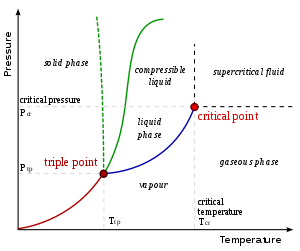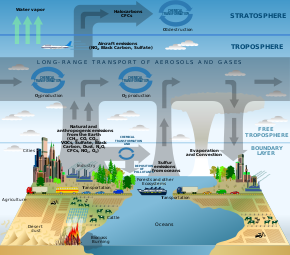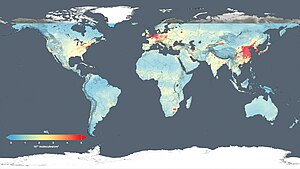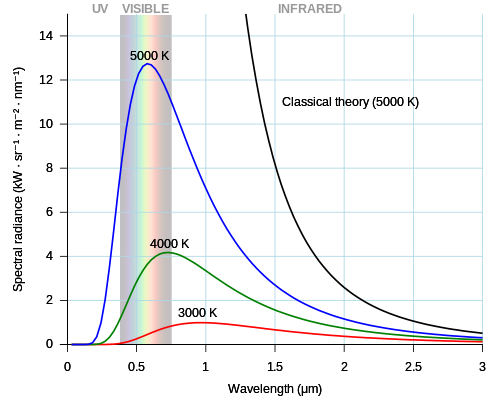From Wikipedia, the free encyclopedia
The Clausius–Clapeyron relation, named after Rudolf Clausius[1] and Benoît Paul Émile Clapeyron,[2] is a way of characterizing a discontinuous phase transition between two phases of matter of a single constituent. On a pressure–temperature (P–T) diagram, the line separating the two phases is known as the coexistence curve. The Clausius–Clapeyron relation gives the slope of the tangents to this curve. Mathematically,
 is the slope of the tangent to the coexistence curve at any point,
is the slope of the tangent to the coexistence curve at any point,  is the specific latent heat,
is the specific latent heat,  is the temperature,
is the temperature,  is the specific volume change of the phase transition, and
is the specific volume change of the phase transition, and  is the specific entropy change of the phase transition.
is the specific entropy change of the phase transition.Derivations
Derivation from state postulate
Using the state postulate, take the specific entropy for a homogeneous substance to be a function of specific volume
for a homogeneous substance to be a function of specific volume  and temperature
and temperature  .[3]:508
.[3]:508 is the pressure. Since pressure and temperature are constant, by definition the derivative of pressure with respect to temperature does not change.[4][5]:57, 62, 671 Therefore, the partial derivative of specific entropy may be changed into a total derivative
is the pressure. Since pressure and temperature are constant, by definition the derivative of pressure with respect to temperature does not change.[4][5]:57, 62, 671 Therefore, the partial derivative of specific entropy may be changed into a total derivative to a final phase
to a final phase  ,[3]:508 to obtain
,[3]:508 to obtain and
and  are respectively the change in specific entropy and specific volume. Given that a phase change is an internally reversible process, and that our system is closed, the first law of thermodynamics holds
are respectively the change in specific entropy and specific volume. Given that a phase change is an internally reversible process, and that our system is closed, the first law of thermodynamics holds is the internal energy of the system. Given constant pressure and temperature (during a phase change) and the definition of specific enthalpy
is the internal energy of the system. Given constant pressure and temperature (during a phase change) and the definition of specific enthalpy  , we obtain
, we obtain gives
gives ), we obtain[3]:508[6]
), we obtain[3]:508[6] , at any given point on the curve, to the function
, at any given point on the curve, to the function  of the specific latent heat
of the specific latent heat  , the temperature
, the temperature  , and the change in specific volume
, and the change in specific volume  .
.Derivation from Gibbs–Duhem relation[edit]
Suppose two phases, and
and  , are in contact and at equilibrium with each other. Their chemical potentials are related by
, are in contact and at equilibrium with each other. Their chemical potentials are related by is the specific entropy,
is the specific entropy,  is the specific volume, and
is the specific volume, and  is the molar mass) to obtain
is the molar mass) to obtainIdeal gas approximation at low temperatures
When the phase transition of a substance is between a gas phase and a condensed phase (liquid or solid), and occurs at temperatures much lower than the critical temperature of that substance, the specific volume of the gas phase greatly exceeds that of the condensed phase
greatly exceeds that of the condensed phase  . Therefore, one may approximate
. Therefore, one may approximate is the pressure,
is the pressure,  is the specific gas constant, and
is the specific gas constant, and  is the temperature. Substituting into the Clapeyron equation
is the temperature. Substituting into the Clapeyron equation is the specific latent heat of the substance.
is the specific latent heat of the substance.Let
 and
and  be any two points along the coexistence curve between two phases
be any two points along the coexistence curve between two phases  and
and  . In general,
. In general,  varies between any two such points, as a function of temperature. But if
varies between any two such points, as a function of temperature. But if  is constant,
is constant,Applications
Chemistry and chemical engineering
For transitions between a gas and a condensed phase with the approximations described above, the expression may be rewritten as is a constant. For a liquid-gas transition,
is a constant. For a liquid-gas transition,  is the specific latent heat (or specific enthalpy) of vaporization; for a solid-gas transition,
is the specific latent heat (or specific enthalpy) of vaporization; for a solid-gas transition,  is the specific latent heat of sublimation. If the latent heat is known, then knowledge of one point on the coexistence curve determines the rest of the curve. Conversely, the relationship between
is the specific latent heat of sublimation. If the latent heat is known, then knowledge of one point on the coexistence curve determines the rest of the curve. Conversely, the relationship between  and
and  is linear, and so linear regression is used to estimate the latent heat.
is linear, and so linear regression is used to estimate the latent heat.Meteorology and climatology
Atmospheric water vapor drives many important meteorologic phenomena (notably precipitation), motivating interest in its dynamics. The Clausius–Clapeyron equation for water vapor under typical atmospheric conditions (near standard temperature and pressure) is is saturation vapor pressure
is saturation vapor pressure is temperature
is temperature is the specific latent heat of evaporation of water
is the specific latent heat of evaporation of water is the gas constant of water vapor
is the gas constant of water vapor
 , and therefore of the saturation vapor pressure
, and therefore of the saturation vapor pressure  , cannot be neglected in this application. Fortunately, the August-Roche-Magnus formula provides a very good approximation, using pressure in hPa and temperature in Celsius:
, cannot be neglected in this application. Fortunately, the August-Roche-Magnus formula provides a very good approximation, using pressure in hPa and temperature in Celsius:(This is also sometimes called the Magnus or Magnus-Tetens approximation, though this attribution is historically inaccurate.[9])
Under typical atmospheric conditions, the denominator of the exponent depends weakly on
 (for which the unit is Celsius). Therefore, the August-Roche-Magnus equation implies that saturation water vapor pressure changes approximately exponentially with temperature under typical atmospheric conditions, and hence the water-holding capacity of the atmosphere increases by about 7% for every 1 °C rise in temperature.[10]
(for which the unit is Celsius). Therefore, the August-Roche-Magnus equation implies that saturation water vapor pressure changes approximately exponentially with temperature under typical atmospheric conditions, and hence the water-holding capacity of the atmosphere increases by about 7% for every 1 °C rise in temperature.[10]Example
One of the uses of this equation is to determine if a phase transition will occur in a given situation. Consider the question of how much pressure is needed to melt ice at a temperature below 0 °C. Note that water is unusual in that its change in volume upon melting is negative. We can assume
below 0 °C. Note that water is unusual in that its change in volume upon melting is negative. We can assume = 3.34×105 J/kg (latent heat of fusion for water),
= 3.34×105 J/kg (latent heat of fusion for water), = 273 K (absolute temperature), and
= 273 K (absolute temperature), and = −9.05×10−5 m³/kg (change in specific volume from solid to liquid),
= −9.05×10−5 m³/kg (change in specific volume from solid to liquid),
 = −13.5 MPa/K.
= −13.5 MPa/K.
Second derivative
While the Clausius–Clapeyron relation gives the slope of the coexistence curve, it does not provide any information about its curvature or second derivative. The second derivative of the coexistence curve of phases 1 and 2 is given by [12] is the specific heat capacity at constant pressure,
is the specific heat capacity at constant pressure,  is the thermal expansion coefficient, and
is the thermal expansion coefficient, and  is the isothermal compressibility.
is the isothermal compressibility.




























 is
is  is the
is the  is the
is the 

 = −13.5 MPa/K.
= −13.5 MPa/K.



